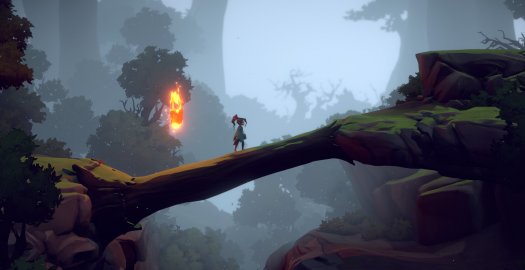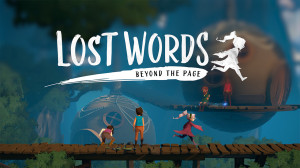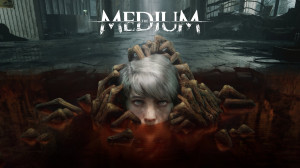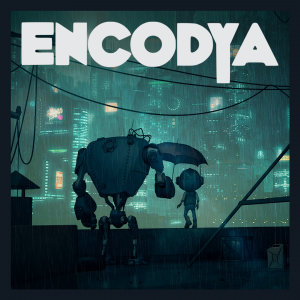Review for Lost Words: Beyond the Page

Adventure gamers are used to the concept of words changing the world around us, whether through a verb interface or a dialogue tree. Lost Words: Beyond the Page takes that idea a step further, putting you in the shoes of a young girl who physically navigates the pages of her journal as she reflects on the turmoil in her life and invents a fantasy tale to escape and process it. The story is penned by Rhianna Pratchett, perhaps best known for her work on the Tomb Raider reboot series, and does a good job of providing believable insight into a troubled adolescent’s emotions. However, despite a novel premise and some appealing visuals, the game fails to make the most of its potential, with a lot of time wasted on simple and uninspired platforming sections.
Izzy dreams of becoming a writer, and she gets her chance when given a journal by her grandma for her birthday. It’s here that we meet the young protagonist: inside her journal – literally. You take control of a small illustrated character with flowing black hair, hopping around the actual pages of the book that rests on the real Izzy’s desk. As she reflects on her day or ponders the future, Izzy’s words begin to appear on the paper, accompanied by watercolour sketches – and sometimes her cat’s paws! Your aim is simply to move to the next page, which you achieve by clambering along the written words and jumping between sentences. You might also need to move some of the words to build a staircase, land on a highlighted word to inspire Izzy to pen some more, or even use verbs to animate a drawing (like dragging “blow” near birthday candles to extinguish them).
These sections are really quite wonderful and reminded me of Disney’s Winnie the Pooh animations, where the characters interact with the words of the book they’re in. Since you’re essentially inside Izzy’s raw thoughts, an emotional connection is quickly established with her. Early in the narrative, Izzy’s grandma falls ill and is taken to hospital, and thus much of her chronicling is spent coming to terms with the situation and working through her feelings. Throughout it all, the writing is authentic to that of a child’s first experience with grief. Izzy goes through a range of emotions like anger, upset and guilt, and you genuinely feel for her. She’s also suitably naïve about some things, such as her knowledge about religion amounting to enjoying the stories, “especially the one about the ark and rescuing all the animals,” and being confused as to why her “strong” mum is crying. These innocent musings lead to still more poignant moments.
Some of the best parts of Lost Words are when the pages come completely alive, like when Izzy is describing a trip to the beach and sparkling blue waves slide into the journal, lapping back and forth and moving the words with them. Or when she’s reminiscing about watching Star Wars on VHS, her sentences scrolling up the page to mimic that film’s famous title crawl. And yet some of the simpler moments are the most touching and effective, such as when Izzy can’t get the image of her ailing grandma out of her mind – as you jump between photos of the pair in happier times, they fade into a shot of the elderly woman in a hospital bed. It’s rare that one page is ever like the last, either in terms of the layout or the interaction, and that helps keep the experience feeling fresh.
To impress and cheer up her grandma, Izzy decides to write a fantasy story set in a land of peace and magic called Estoria. Therein lives a girl called Robyn, recognisable by her purple dress (in my case, at least – you can choose her name and outfit colour). Here the gameplay leaves the journal and becomes a more traditional side-scrolling platformer, complete with change to 3D models. This tale begins on Robyn’s birthday, as she inherits the title of village guardian from a wise matriarch called Elder Ava. Unfortunately, an evil dragon invades Estoria, setting fire to everyone’s homes and scattering the magical fireflies that give the village its energy. Robyn then sets out on an adventure to recover the fireflies and confront the dragon. As you’ve no doubt guessed, the events of Izzy’s reality are being metaphorically reflected in her story.
Lost Words moves back and forth between the journal and Estoria. Unfortunately, most of your time is spent in the latter, and it’s here that the game stumbles. It begins promisingly: in your new guardian role, you’re gifted a magical book that contains up to six words at one time (some come and go; others are persistent), which you can drag into the environment like a more traditional inventory item to overcome obstacles (signified by their glowing blue aura, so there’s no guesswork required). For example, “rise” can move a pesky pile of rubble or let you ascend a pulley-powered lift, while “repair” can put bridges or statues back together. You directly control Robyn’s movements with the keyboard and use your mouse to place the words, or you can use a gamepad – one stick controls movement, the other the cursor. Both work fine, though I preferred the quicker positioning the mouse offers.
I really liked the idea behind this concept, but it’s never used in particularly inventive ways. There’s virtually no challenge for a start, since it’s always obvious what you need to do, and the same words are usually used on the same things (“burn” on plants and torches, “break” on stone barriers). If there were a bit more experimentation required or words used less literally, I think it would have helped elevate the experience. Instead it feels like you’re endlessly stuck in a tutorial, waiting for the real game to burst through, but it never comes.
As you move through Estoria, Izzy’s narration appears on-screen, cleverly positioned and paced to complement your actions, like a new word appearing each time you hop a step up a stone staircase. Elsewhere the phrase “as the waters calmed” is shown gently bobbing in a lake, while “weeeee!” appears in huge letters as you slide down a hill. Again, though, this seems like a missed opportunity to do something more. It would have been better if these descriptions impacted the surroundings or could be used to build objects or overcome obstacles. Serving as a meaningful gameplay mechanic rather than something purely aesthetic, similar to how the journal gameplay works, would help elevate the experience from being a rather middling platformer.
Occasionally the screen rips, the journal visible beneath, and you get to make a choice that slightly affects the story on a surface level. For example, deciding what type of people lived in the desert will alter the design of half-buried statues, and selecting a food will determine what sort of treat a friend likes to devour. It’s nothing spectacular, or anything that will warrant repeat playthroughs, but it’s nice to have a small hand in telling the tale.
This is all set against a generic fantasy landscape, though it is nicely realised in colourful and smooth side-scrolling 3D. While you’re running along a flat plane, there’s a good sense of depth as the environment fades off in the background. The barren desert is covered in sand, with creepy twisted trees silhouetted in the distance and the hazy sun beaming down. The underwater tunnels feature deep blues, with shimmering coral and fish swimming around. Then there’s the glowing red caves, with their flowing lava and hanging stalactites. While these locales look nice enough, the actual level design leaves a lot to be desired. They’re often quite empty, so a lot of time is spent running through sparse spaces, occasionally crawling, jumping over something or employing a magic word. There’s little sense of wonder or discovery and it’s all very “my first platformer.”
Your aim here of course is to make it to the other side in pursuit of the dragon you sometimes see swooping around imposingly in the background. Along the way you can also collect the scattered fireflies. There are around twenty to find in each level, though it’s not taxing since most of them are on the path you have to take anyway. A few are located slightly off-course (like going all the way to the top of a rope rather than immediately swinging from it), but I managed to collect all but a couple without really trying. As you nab a firefly, a counter appears displaying your progress for that level, but you won’t be penalized for missing any and you can always replay a level if you get that completionist itch.
You’ll encounter other folk in your travels, like an unwelcoming djinn and an angry flame incarnate, but the time spent with them is so fleeting, the words exchanged so brief that it never amounts to anything meaningful. One character’s journey is designed to tug your heartstrings, but it doesn’t land since you’ve barely built a connection. The basic fantasy framework fits the game’s conceit of being the product of a child’s imagination and her first crack at weaving a yarn, but it doesn’t translate to interesting gameplay. There is one welcome exception to this: the ending, which takes an unexpected turn. It breaks away from the mould, strips the colour from the world, and does a good job of showing Izzy’s growth.
As both the narrator Izzy and the explorer Robyn, Sidonie Maria Šakālis does a superb job of portraying the dual protagonists’ joyfulness and despair, and everything in between. She moves between quieter moments of reflection and jubilant excitement with ease, imbuing each line perfectly with a sense of childlike innocence. Most of the supporting cast do a fine job too, though you don’t hear much from them. There are a couple of duds, however, most notably the giantess who sounds strained and unnatural, perhaps a fault of the post-processing effects, and the little fire companion Lump who falls on the annoying side of childish.
Notable too is the soundtrack, created by David Housden and performed by the Nashville Music Scoring Orchestra. There’s effective use of strings and piano to create tracks that twinkle and soar during moments of hope, and playful percussion to create an excited sense of the unknown. Other tracks evoke feelings of melancholy and sadness with a slower tempo. One of the more memorable recurring tunes is the bombastic theme that plays whenever you see the dragon, which is suitably grand and imposing.
I suspect Lost Words: Beyond the Page will be most appreciated by younger gamers or those who favour a good story and are willing to tolerate some iffy platforming to get it. The writing is strong and believable, likely to stir even the hardest heart, and it maintains Izzy’s authentic voice throughout. While it deals with some mature themes, the game presents them in a simple yet effective way, allowing the focus to remain on the protagonist’s emotional tale rather than the frustration of dealing with complex gameplay. The experience is short at around four hours, nicely suited to while away some free time in between longer adventures. It’s a shame, though, that no matter how good the voice acting or how pretty the art, the superficial nature of the gameplay is rather disappointing throughout. The journal sections are undoubtedly the best – charming, clever, and probably worth playing Lost Words for alone – but too much time is spent on dull platforming for it to capitalise on the potential its magical word concept had to offer.



























